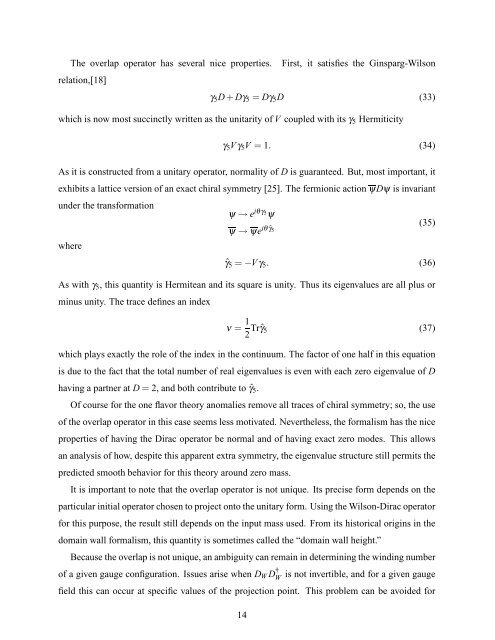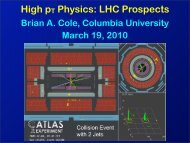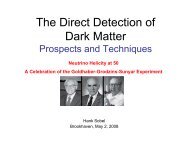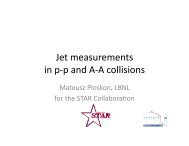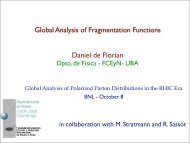One flavor QCD Abstract - BNL theory groups - Brookhaven National ...
One flavor QCD Abstract - BNL theory groups - Brookhaven National ...
One flavor QCD Abstract - BNL theory groups - Brookhaven National ...
You also want an ePaper? Increase the reach of your titles
YUMPU automatically turns print PDFs into web optimized ePapers that Google loves.
The overlap operator has several nice properties. First, it satisfies the Ginsparg-Wilson<br />
relation,[18]<br />
γ 5 D+Dγ 5 = Dγ 5 D (33)<br />
which is now most succinctly written as the unitarity of V coupled with its γ 5 Hermiticity<br />
γ 5 Vγ 5 V = 1. (34)<br />
As it is constructed from a unitary operator, normality of D is guaranteed. But, most important, it<br />
exhibits a lattice version of an exact chiral symmetry [25]. The fermionic action ψDψ is invariant<br />
under the transformation<br />
where<br />
ψ → e iθγ 5ψ<br />
ψ → ψe iθ ˆγ 5<br />
(35)<br />
ˆγ 5 = −V γ 5 . (36)<br />
As with γ 5 , this quantity is Hermitean and its square is unity. Thus its eigenvalues are all plus or<br />
minus unity. The trace defines an index<br />
ν = 1 2 Tr ˆγ 5 (37)<br />
which plays exactly the role of the index in the continuum. The factor of one half in this equation<br />
is due to the fact that the total number of real eigenvalues is even with each zero eigenvalue of D<br />
having a partner at D = 2, and both contribute to ˆγ 5 .<br />
Of course for the one <strong>flavor</strong> <strong>theory</strong> anomalies remove all traces of chiral symmetry; so, the use<br />
of the overlap operator in this case seems less motivated. Nevertheless, the formalism has the nice<br />
properties of having the Dirac operator be normal and of having exact zero modes. This allows<br />
an analysis of how, despite this apparent extra symmetry, the eigenvalue structure still permits the<br />
predicted smooth behavior for this <strong>theory</strong> around zero mass.<br />
It is important to note that the overlap operator is not unique. Its precise form depends on the<br />
particular initial operator chosen to project onto the unitary form. Using the Wilson-Dirac operator<br />
for this purpose, the result still depends on the input mass used. From its historical origins in the<br />
domain wall formalism, this quantity is sometimes called the “domain wall height.”<br />
Because the overlap is not unique, an ambiguity can remain in determining the winding number<br />
of a given gauge configuration. Issues arise when D W D † W<br />
is not invertible, and for a given gauge<br />
field this can occur at specific values of the projection point. This problem can be avoided for<br />
14


